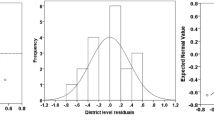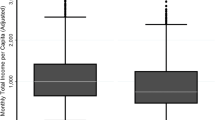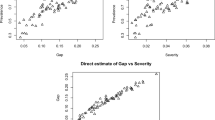Abstract
Sustainable development goal-1 of the United Nations is to end poverty in all its forms everywhere. The estimates of poverty related parameters obtained from large scale sample survey are often available at large domain level (e.g. state level). But, poverty rates are not uniformly distributed across the regions. The regional variations are masked in such large domain level estimates. However, for monitoring the progress of poverty alleviation programmes aimed at reduction of poverty often require micro or disaggregate level estimates. The traditional survey estimation approaches are not suitable for generating the reliable estimates at this level because of sample size problem. It is the main endeavor of Small Area Estimation (SAE) approach to produce micro level statistics with acceptable precision without incurring any extra cost and utilizing existing survey data. In this study, the Hierarchical Bayes approach of SAE has been applied to generate reliable and representative district level poverty incidence for the State of Odisha in India using the Household Consumer Expenditure Survey 2011–2012 data of National Sample Survey Office and linked with Population Census 2011. The results show the precise performance of model based estimates generated by SAE method to a greater extent than the direct survey estimates. A poverty map has also been produced to observe the spatial inequality in poverty distribution.






Similar content being viewed by others
References
Benjamin, M., Stoker, T., & Suri, T. (2013). The economics of slums in the developing world. Journal of Economic Perspectives, 27(4), 187–210.
Census. (2011). Primary Census Abstracts, Registrar General of India, Ministry of Home Affairs, Government of India. http://www.censusindia.gov.in/2011census/population_enumeration.html.
Chandra, H. (2013). Exploring spatial dependence in area-level random effect model for disaggregate-level crop yield estimation. Journal of Applied Statistics, 40(4), 823–842.
Chandra, H., Aditya, K., & Sud, U. C. (2018a). Localised estimates and spatial mapping of poverty incidence in the state of Bihar in India-an application of small area estimation techniques. PLoS ONE. https://doi.org/10.1371/journal.pone.0198502.
Chandra, H., Salvati, N., & Chambers, R. (2017). Small area prediction of counts under a non-stationary spatial model. Spatial Statistics, 20, 30–56.
Chandra, H., Salvati, N., & Chambers, R. (2018b). Small area estimation under a spatially non-linear model. Computational Statistics & Data Analysis, 126, 19–38.
Chandra, H., Salvati, N., & Sud, U. C. (2011). Disaggregate-level estimates of indebtedness in the state of Uttar Pradesh in India—An application of small area estimation technique. Journal of Applied statistics, 38(11), 2413–2432.
Chaudhuri, S., & Gupta, N. (2009). Levels of living and poverty patterns: A district-wise analysis for India. Economic & Political Weekly, XLIV(9), 94–110.
Chauhan, R. K., Mohanty, S. K., Subramanian, S. V., Parida, J. K., & Padhi, B. (2016). Regional estimates of poverty and inequality in India, 1993–2012. Social Indicators Research, 127, 1249–1296.
Coondoo, D., Majumder, A., & Chattopadhyay, S. (2011). District-level poverty estimation: A proposed method. Journal of Applied Statistics, 38(10), 2327–2343.
Fay, R. E., & Herriot, R. A. (1979). Estimates of income for small places: An application of James–Stein procedures to census data. Journal of the American Statistical Association, 74, 269–277.
Gelman, A. (2006). Prior distributions for variance parameters in hierarchical models. Bayesian Analysis, 1, 515–533.
Ghosh, M., Kim, D., Sinha, K., Maiti, T., Katzoff, M., & Parsons, V. L. (2009). Hierarchical and empirical Bayes small domain estimation of the proportion of persons without health insurance of minority subpopulations. Survey Methodology, 35, 53–66.
Government of India. (2017). Millennium development goals—Final country report of India. Central Statistics Office, Ministry of Statistics and Programme Implementation, Government of India. http://mospi.nic.in/sites/dfault/files/publication_reports/MDG_Final_Country_report_of_India_27nov17.pdf. Accessed 27 Nov 2017.
Jiang, J., & Lahiri, P. (2006). Mixed model prediction and small area estimation. Test, 15, 111–999.
Kabeer, N. (1994). “Beyond the poverty line: Measuring poverty and impoverishing measures” in reversed realities: Gender hierarchies in development thoughts (pp. 136–162). London: Yerso.
Kish, L. (1965). Survey sampling. New York: Wiley.
Lee, D., Minton, J., & Pryce, G. (2015). Bayesian inference for the dissimilarity index in the presence of spatial autocorrelation. Spatial Statistics, 11, 81–95.
Liu, B., Lahiri, P., & Kalton, G. (2014). Hierarchical Bayes modeling of survey-weighted small area proportions. Survey Methodology, 40, 1–13.
Mohanty, S. K., Govil, D., Chauhan, R. K., Kim, R., & Subramanian, S. V. (2016). Estimates of poverty and inequality in the districts of India, 2011–2012. Journal of Development Policy and Practice, 1(2), 142–202.
Molina, I., Salvati, N., & Pratesi, M. (2009). Bootstrap for estimating the MSE of the spatial EBLUP. Computational Statistics, 24, 441–458.
Narayana, D., & Petesch, P. (2002). Voices of the poor: From many lands World Bank. New York: Oxford University Press.
Portar, A. T., Holan, S. H., Wikle, C. K., & Cressie, N. (2014). Spatial Fay–Herriot models for small area estimation with functional covariates. Spatial Statistics, 10, 27–42.
Pratesi, M., & Salvati, N. (2009). Small area estimation in presence of correlated random area effects. Journal of Official Statistics, 25, 37–53.
Pratesi, M., & Salvati, N. (2016). Introduction on measuring poverty at local level using small area estimation methods. Pratesi/Analysis of poverty data by small area estimation (pp. 1–18). New York: Wiley.
Rao, J. N. K. (2003). Small area estimation. New York: Wiley.
Rao, J. N. K., & Molina, I. (2015). Small area estimation (2nd ed.). New York: Wiley.
Sen, A. K. (1981). Poverty and famines: An essay on entitlements and deprivation. Oxford: Clarendon Press.
Souza, D. F., Moura, F. A. S., & Migon, H. S. (2009). Small area population prediction via hierarchical models. Survey Methodology, 35, 203–214.
United Nations. (2017). The sustainable development goals report. http://www.un.org/sustainabledevelopment/poverty/. Accessed 15 Dec 2017.
You, Y. (2008). An integrated modeling approach to unemployment rate estimation for sub-provincial areas of Canada. Survey Methodology, 34, 19–27.
You, Y., & Rao, J. N. K. (2002). Small area estimation using unmatched sampling and linking models. The Canadian Journal of Statistics, 30, 3–15.
Acknowledgements
The authors would like to acknowledge the valuable comments and suggestions of the Editor and two anonymous referees. These led to a considerable improvement in the paper.
Author information
Authors and Affiliations
Corresponding author
Appendix
Appendix
Full conditional distributions for the Gibbs sampler under four HB models are presented below. Let, \(\tilde{p}\, = \,\left( {p_{1w} , \ldots ,p_{mw} } \right)^{T}\), \({\mathbf{P}}\, = \,\left( {P_{1} , \ldots ,P_{m} } \right)^{T}\), \({\mathbf{X}}\, = \,\left( {{\mathbf{x}}_{1}^{T} , \ldots ,{\mathbf{x}}_{m}^{T} } \right)^{T}\), \({\mathbf{x}}_{i}^{T} = \,\left( {x_{i1} , \ldots ,x_{ik} } \right)\), \({\varvec{\upbeta}}\,{ = }\,\left( {\beta_{1} , \ldots ,\beta_{k} } \right)^{T}\) and k represents number of auxiliary variates and usually \(x_{i1}\) is taken to be 1 \(\forall \,\,{\text{i = }}\,1, \ldots ,{\text{m}}\).
The full conditional distributions for the M1 are given as,
-
(1)
$$P_{i} \,|\,{\varvec{\upbeta}},\,\sigma_{v}^{2} ,\,\tilde{p}\sim\,N\,\left( {\frac{{\sigma_{v}^{2} }}{{\sigma_{v}^{2} + \,\sigma_{ei}^{2} }}\,p_{iw} \, + \,\frac{{\sigma_{ei}^{2} }}{{\sigma_{v}^{2} + \,\sigma_{ei}^{2} }}{\mathbf{x}}_{i}^{T} {\varvec{\upbeta}},\,\frac{{\sigma_{ei}^{2} \sigma_{v}^{2} }}{{\sigma_{v}^{2} + \,\sigma_{ei}^{2} }}} \right)\,;$$
-
(2)
$${\varvec{\upbeta}}\, |\,P_{i} ,\,\sigma_{v}^{2} ,\,{\tilde{\text{p}}}\,\sim\,{\text{N}}\,\,\left( {\left( {{\mathbf{X}}^{T} {\mathbf{X}}} \right)^{ - 1} {\mathbf{X}}^{T} {\mathbf{P}} ,\,\sigma_{\text{v}}^{ 2} \left( {{\mathbf{X}}^{T} {\mathbf{X}}} \right)^{ - 1} } \right)\,;$$
-
(3)
$$\sigma_{v}^{2} \,|\,{\varvec{\upbeta}},\,P_{i} ,\,\tilde{p}\,\sim\,IG\,\left( {a + \frac{m}{2},\,\,b + \,\frac{{\sum\limits_{i = 1}^{m} {\left( {P_{i} \, - \,{\mathbf{x}}_{i}^{T} {\varvec{\upbeta}}} \right)^{2} } }}{2}} \right).$$
The full conditional distributions for the M2 are given as follows,
-
(1)
$$P_{i} \,|\,{\varvec{\upbeta}},\,\sigma_{v}^{2} ,\,\tilde{p}\, \propto \,\frac{1}{{P_{i} \,\left( {1 - \,P_{i} } \right)\sqrt {\sigma_{ei}^{2} \sigma_{v}^{2} } \,}}\,\exp \left( { - \,\frac{{\left( {p_{iw} \, - P_{i} \,\,} \right)^{2} }}{{2\sigma_{ei}^{2} }}\, - \,\frac{{\left( {\log it\left( {P_{i} } \right)\, - {\mathbf{x}}_{i}^{T} {\varvec{\upbeta}}\,\,} \right)^{2} }}{{2\sigma_{v}^{2} }}} \right)\,;$$
-
(2)
$${\varvec{\upbeta}}\, |\,{\text{P}}_{\text{i}} ,\,\sigma_{\text{v}}^{ 2} ,\,{\tilde{\text{p}}}\sim\,{\text{N}}\,\,\left( {\left( {{\mathbf{X}}^{T} {\mathbf{X}}} \right)^{ - 1} {\mathbf{X}}^{T} {\text{logit}}({\mathbf{P}}) ,\,\sigma_{\text{v}}^{ 2} \left( {{\mathbf{X}}^{T} {\mathbf{X}}} \right)^{ - 1} } \right)\,;$$
-
(3)
$$\sigma_{v}^{2} \,|\,{\varvec{\upbeta}},\,P_{i} ,\,\tilde{p}\,\sim\,IG\,\left( {a + \frac{m}{2},\,\,b + \,\frac{{\sum\limits_{i = 1}^{m} {\left( {\log it\left( {P_{i} } \right) - \,{\mathbf{x}}_{i}^{T} {\varvec{\upbeta}}} \right)^{2} } }}{2}} \right).$$
The full conditional distributions for the M3 are given as below,
-
(1)
$$P_{i} \,|\,{\varvec{\upbeta}},\,\sigma_{v}^{2} ,\,\tilde{p}\, \propto \,\frac{1}{{P_{i} \,\left( {1 - \,P_{i} } \right)\sqrt {\,\,\xi_{i} \sigma_{v}^{2} } \,}}\,\exp \left( { - \,\frac{{\left( {p_{iw} \, - P_{i} } \right)^{2} }}{{2\,\xi_{i} }}\, - \,\frac{{\left( {\log it\left( {P_{i} } \right)\, - {\mathbf{x}}_{i}^{T} {\varvec{\upbeta}}\,\,} \right)^{2} }}{{2\sigma_{v}^{2} }}} \right)\,;$$
-
(2)
$${\varvec{\upbeta}}\, |\,P_{i} ,\,\sigma_{\text{v}}^{ 2} ,\,{\tilde{\text{p}}}\,\sim\,{\text{N}}\,\,\left( {\left( {{\mathbf{X}}^{T} {\mathbf{X}}} \right)^{ - 1} {\mathbf{X}}^{T} {\text{logit}}\left( {\mathbf{P}} \right) ,\,\sigma_{\text{v}}^{ 2} \left( {{\mathbf{X}}^{T} {\mathbf{X}}} \right)^{ - 1} } \right)\,;$$
-
(3)
$$\sigma_{v}^{2} \,|\,{\varvec{\upbeta}},\,P_{i} ,\,\tilde{p}\,\sim\,IG\,\left( {a\, + \frac{m}{2},\,\,b\,\, + \,\,\frac{{\sum\limits_{i = 1}^{m} {\left( {\log it\,\left( {P_{i} } \right)\, - \,{\mathbf{x}}_{i}^{T} {\varvec{\upbeta}}} \right)^{2} } }}{2}} \right).$$
Let, \(\delta_{i} \, = \,\frac{{n_{i} }}{{deff_{i} }} - 1\).
Then the full conditional distributions for the M4 are given as follows,
-
(1)
$$P_{i} \,|\,{\varvec{\upbeta}},\,\sigma_{v}^{2} ,\,\tilde{p}\, \propto \,\frac{1}{{P_{i} \,\left( {1 - \,P_{i} } \right)\sqrt {\,\,\sigma_{v}^{2} } \,}}\,\frac{{p_{iw}^{{P_{i} \delta_{i} \, - \,1}} \,\left( {1 - \,p_{iw} } \right)^{{(1 - \,P_{i} )\delta_{i} \, - \,1}} }}{{\varGamma \,\left( {P_{i} \delta_{i} } \right)\,\varGamma \left( {\left( {1 - \,P_{i} } \right)\delta_{i} } \right)\,}}\exp \left( { - \,\,\frac{{\left( {\log it\left( {P_{i} } \right)\, - {\mathbf{x}}_{i}^{T} {\varvec{\upbeta}}\,\,} \right)^{2} }}{{2\sigma_{v}^{2} }}} \right)\,;$$
-
(2)
$${\varvec{\upbeta}}\, |\,P_{i} ,\,\sigma_{\text{v}}^{ 2} ,\,{\tilde{\text{p}}}\,\sim\,{\text{N}}\,\,\left( {\left( {{\mathbf{X}}^{T} {\mathbf{X}}} \right)^{ - 1} {\mathbf{X}}^{T} {\text{logit}}\left( {\mathbf{P}} \right) ,\,\sigma_{\text{v}}^{ 2} \left( {{\mathbf{X}}^{T} {\mathbf{X}}} \right)^{ - 1} } \right)\,;$$
-
(3)
$$\sigma_{v}^{2} \,|\,{\varvec{\upbeta}},\,P_{i} ,\,\tilde{p}\,\sim\,IG\,\left( {a\, + \frac{m}{2},\,\,b\,\, + \,\,\frac{{\sum\limits_{i = 1}^{m} {\left( {\log it\,\left( {P_{i} } \right)\, - \,{\mathbf{x}}_{i}^{T} {\varvec{\upbeta}}} \right)^{2} } }}{2}} \right).$$
Rights and permissions
About this article
Cite this article
Anjoy, P., Chandra, H. & Basak, P. Estimation of Disaggregate-Level Poverty Incidence in Odisha Under Area-Level Hierarchical Bayes Small Area Model. Soc Indic Res 144, 251–273 (2019). https://doi.org/10.1007/s11205-018-2050-9
Accepted:
Published:
Issue Date:
DOI: https://doi.org/10.1007/s11205-018-2050-9




